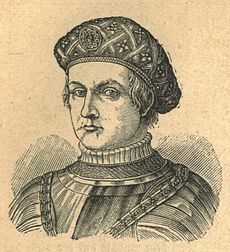Friedrich II Brandenburg , Friedrich Iron , Friedrich Iron tooth ( German: Friedrich II. Von Brandenburg ; , - , ) - Elector and Margrave of the Brandenburg Mark in 1437-1470.
| Frederick II of Brandenburg | |||||||
|---|---|---|---|---|---|---|---|
| him Friedrich II. von Brandenburg | |||||||
 | |||||||
 coat of arms of the Hohenzollern | |||||||
| |||||||
| Predecessor | Frederick I | ||||||
| Successor | Albrecht III | ||||||
| Birth | |||||||
| Death | |||||||
| Burial place | |||||||
| Rod | Hohenzollern | ||||||
| Father | |||||||
| Mother | |||||||
| Spouse | |||||||
| Children | Dorothea , Margarita , Johann, Erasmus | ||||||
The second son of Frederick I and Elizabeth of Bavaria at the age of 8 was betrothed to the hereditary princess of Poland, Jadwig Jagailowna, and was brought up in Poland for ten years. The sudden death of the bride left a deep imprint in the soul of Frederick, who had suffered from melancholy all his life.
In 1437 Frederick headed the brand. Continuing the policy of his father, he led the struggle with the estates, broke the autonomy of the nobility. But in his policy, he deliberately avoided imperial tendencies, refused the crowns of Poland and Bohemia offered to him, and preferred to devote himself to strengthening his elector. For this, he restricted the independence of the united Berlin - Cologne and urban unions in the Brandenburg Mark, depriving them of their liberties, and based on Spree, between Cologne and Berlin, a fortress.
In 1451 the construction of the cathedral palace was completed. With hereditary treaties with Mecklenburg, Saxony, and Hesse, he protected the Elector from external threats. In 1454, Friedrich redeemed the New Mark from the Teutonic Order for 40 thousand guilders.
Attached to his possessions Cottbus , Neumark , Talberg - Wernigerode , Altmark ; because of Luzia, he entered the fight against Georgy Podebrady and, in 1462, in the world in Guben, he refused to intend to join Lužica (Lausitz); The attempt to seize the Pomeranian-Stettin lands, where in 1464 the ducal line died out, ended unsuccessfully.
Exhausted by the fruitless struggle against Pomerania , in 1470, Friedrich transferred power to his brother Albrecht-Achilles and retired to Franconia, to Plassenburg fortress , where he died in 1471.
Piety and firmness of will were the main traits of Frederick II. His father devoted much time to the affairs of the empire, but he focused entirely on Brandenburg. The relationship of Frederick to the emperor was always peaceful and friendly.
Descendants
On June 11, 1446, in Wittenberg, Frederick II married Catherine of Saxony , the daughter of the Elector of Saxony, Frederick I. They were born:
- Dorothea (1446–1519), married to Duke Johann IV of Saxe-Lauenburg (1439–1507)
- Margaret (1449 / 50-1489), married to the Duke of Pomerania Bohuslav X (1454-1523)
- Johann (ca. 1452-1454)
- Erasmus (c. 1453-1465), illegitimate son
Notes
- ↑ 1 2 3 4 German National Library , Berlin State Library , Bavarian State Library , etc. Record # 11853565X // Common Regulatory Control (GND) - 2012—2016.
Literature
- Lehnert U. Der Kaiser und die Siegesallee. Réclame Royale. - Berlin: Dietrich Reimer Verlag, 1998. - ISBN 3-496-01189-0 .
- Frederick II Iron Tooth / / Brockhaus and Efron Encyclopedic Dictionary : 86 tons (82 tons and 4 extra). - SPb. , 1890-1907.